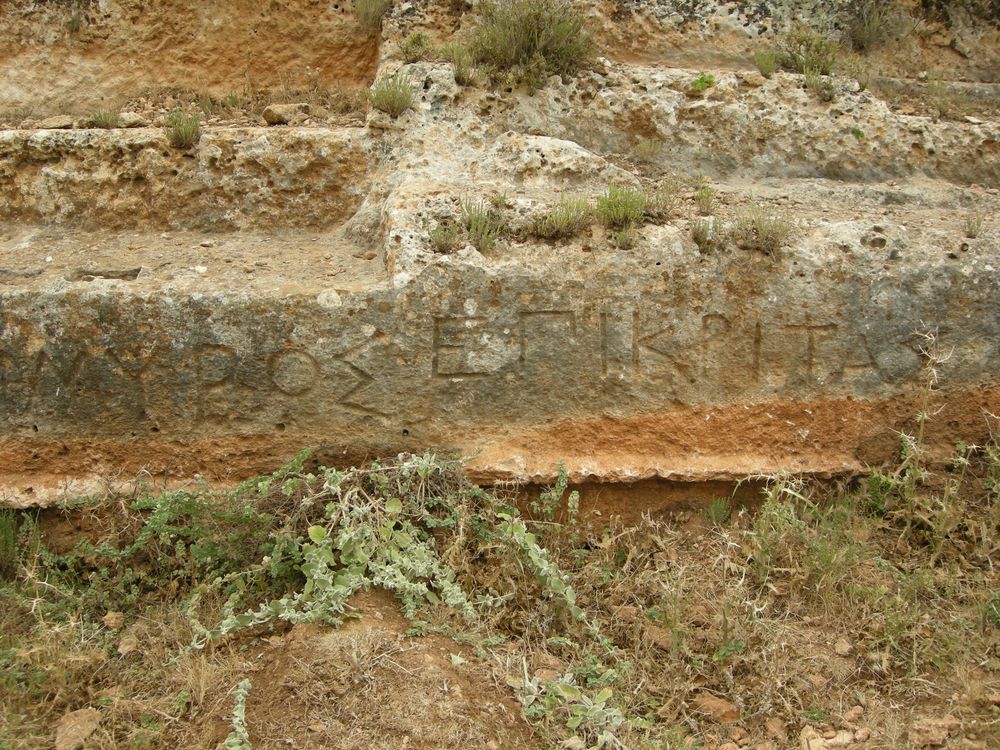EpiDoc XML:
IGCyr1234002
Trismegistos ID:
738783
Source description
Support: Rock-cut tomb with five loculi and a plain facade (dimensions unknown).
Layout: Inscribed in two sections on the facade just above the loculi (one name for each loculus).
Letters: Height unknown, deeply and carefully cut; alpha with low bar, slanting mu and sigma, smaller circular letters, rho with smaller loop in B than in A; the lettering is very similar in both sections, however the guideline for B is no extension of that for A, but is placed slightly higher up.
Date: Probably second half of fourth century BC (context, lettering).
Findspot: First seen and copied by J. Cassels in 1954 at Cyrene ➚: West Necropolis, tomb W128.
Place of origin: Findspot.
Last recorded location: Seen before 2001 by J. Thorn in situ in the West Necropolis. Seen in 2002 by G. D'Addazio in situ. Seen and photographed in 2010 by E. Rosamilia in situ, whence Dobias-Lalou's present edition.
Text constituted from: Transcription from previous mentions (CDL).
Bibliography
Thorn – Thorn 2009, p. 305 (Cassels' copy and Reynolds' test translation); IGCyr 123400 ➚. Cf. D'Addazio 2008, pp. 180-181 (comments on the names).
Text
Apparatus
b.1: Ἐπικρίτας D'Addazio 2008: Ἐπικρ[άτης] Thorn – Thorn 2009 Cassels' diplomatic transcription
French translation
a) (scil. Tombe) de Kallippos et Myrô.
b) (scil. Tombe)d'Epikrita.
English translation
a) (scil. Tomb) of Kallippos and Myro.
b) (scil. Tomb)of Epikrita.
Italian translation
a) (scil. Tomba) di Kallippos e Myrò.
b) (scil. Tomba)di Epikrita.
Commentary
Cassels' unpublished reading was not complete and lacked information about the layout of both sections. J.M. Reynolds' tentative translation communicated to the Thorns is therefore dubitative.
D'Addazio suggested to read section B before section A, which would give both father's and mother's names. This seems impossible in terms of nomenclature, although it is quite possible that the deceased person mentioned at line 2 is a child of the pair mentioned at line 1.
The woman's name Epikrita is already attested on a much later mosaic at Cyrene and corresponds to the masculine Epikritos, rare, but attested elsewhere.
The form Μυρός, dialectal genitive of the woman's name Μυρώι, now supported by IGCyr1388002, corroborates the formerly isolated genitive λεχός at IGCyr0167002, l. 109.
CC BY-NC-SA 4.0 Deed Attribution-NonCommercial-ShareAlike 4.0 International License.
All citation, reuse or distribution of this work must contain a link back to DOI: https://doi.org/10.60760/unibo/igcyrgvcyr2 and the filename (IGCyr000000 or GVCyr000), as well as the year of consultation.



